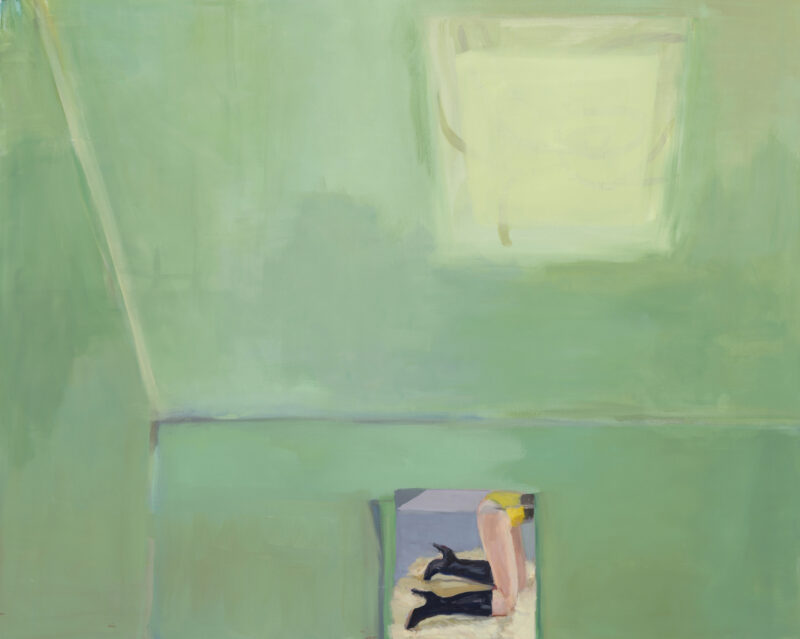
Cruel to Be Kind / Les plus beaux cauchemars
Sep 14, 2023 ― Oct 29, 2023
Please note that the exhibition will be exceptionally closed on the 16th, 29th, and 30th of September, as well as on the 1st and 5th of October.Cruel To Be Kind / Les plus beaux cauchemarsCurated by Anaïs Castro and Alice Ricciardi.Artists: Muriel Ahmarani Jaouich, Véronique Chagnon-Côté, Laura Findlay, Janet Werner, Nicolas Grenier, Chantal Khoury, Élise Lafontaine, Malcolm McCormick, Jérôme Nadeau, GaHee Park, Laurence Pilon, Pierre Dorion, Lan “Florence” YeeLe Livart is proud to present the first exhibition of Pictura 2023, an event dedicated to the presentation and exhibition of contemporary paintings in Montreal.The crises affecting humanity today, whether ecological, political, or social, have brought complex philosophical and ethical dilemmas. As a result, existing in today’s world inevitably implies navigating metaphysical contradictions. In an increasingly polarizing political and economic society, a radical posture is one that precisely defends the intersection. This is a position that avoids being categorical but instead considers one thing through its opposite; seeks one perspective via its obverse. It is an open posture that allows space for dialogue and discourse; it allows itself to be proven wrong. It’s a disposition for empathy.
Cruel To Be Kind / Les plus beaux cauchemars is a project that precisely looks at processes of confluences. It explores the various ways in which forms of practice may be shown to carry contradictory aesthetic structures and ideals while advocating for arenas of discourse and defending positions of compassion, amalgamation, and intersectionality. The project unfolds into three spaces that will open at different intervals throughout the fall of 2023.
The first iteration occurs at Livart and includes thirteen artists working across various painting methods and styles. Here, the exhibition explores spatial contradictions, painting’s ability to represent actual physical spaces accurately, but also to imagine them differently, projecting into distant pasts and futures. Painting also allows the depiction of psychological or theoretical spaces to map metaphysical experiences on bi-dimensional planes. The space of Livart lends itself admirably to these experiments. The specter of this former presbytery remains discernible within the gallery as architectural elements have been preserved, such as wood moldings and fireplaces. Yet, the gallery, completely painted in white, feels bright, modern, fashionable, and almost futuristic. A string of rooms opens up to the large gallery, a vast room with two-story high ceilings accessed through a succession of mirror-covered doorways that make navigating the space feel like being inside a house of mirrors. In many ways, Livart is a playful space, and the selection of artists chosen for the exhibition emphasizes this. Many of them engage conceptually with the idea of play. In a number of works, there’s a slippage from painting into another medium, referencing other artistic practices such as collage, photography, sculpture, architecture, and even digital imaging, thereby testifying to painting’s unique proclivity for mimicry.
Such is the case of Véronique Chagnon-Côté, who depicts urban spaces overrun with digital renderings, both architectural and figurative elements. Pierre Dorion also depicts architectural spaces captured by photography throughout various excursions with confounding accuracy. Dorion’s minimalist compositions, often depicted in monochromatic palettes, flatten the pictorial plane, allowing his work to be considered on a purely formal level as pristinely abstract painted surfaces while retaining a quasi-photographic representation of their original architectural subject. Jérôme Nadeau’s practice exists in a constant straddle between techniques borrowed from photography and material and theory firmly based on the tradition of painting. Similarly, Laura Findlay relies on photographic material, mostly images captured with nighttime flashes, to depict eerie still lives. Her process involves subtractive mark marking borrowed from printmaking techniques, which she skillfully combines with the long-standing tradition of oil painting. Equally provocative is Nicolas Grenier’s practice, which rallies a systematic approach to form and colour akin to that of Les Plasticiens towards an analytical perspective into the complex dynamics of contemporary political discourse. Janet Werner manipulates editorial and advertising images, cropping and folding them, thereby disrupting ‘finished images’ to suspend them in a state of perpetual defeat. This process of deconstruction and reconfiguration withdraws the figure from passive consumption and integrates it into a complex discord of messages that can never be fully assimilated. In this way, her work is at once triumphant and obstructive. In turn, GaHee Park fractures the boundaries between desire and repulsion, positioning the body as a site of delightful magnetism to a lover but one that is equally attractive to the undesired request of a mosquito. Park’s work reminds us that fruits are sweetest and juiciest just before they rot and that everything exists at the threshold of its reverse.
Cruel to Be Kind / Les plus beaux cauchemars is a unique invitation to consider painting’s relevance, dynamism, and capacity for transformative expression. It challenges preconceived notions of the medium of painting by fostering an appreciation for the diversity of voices and perspectives within the realm of painting, from figurative to abstract, from meticulous detail to playful experimentation. The exhibition celebrates the unique qualities of painting as a medium, its ability to reflect reality, imagine alternative models, and convey complex messages through the interplay of form, color, and gesture. It further emphasizes the importance of dialogue, discourse, and compassion by embracing the intersectionality of contrasting perspectives. Certainly, the selected artists offer a strong case for painting’s potential to help us navigate the challenges ahead.Anaïs CastroOpening night on September 14th, 5pm-10pm.
Artwork : Janet Werner, Green Room, 2018
With the kind permission of the artist and the Majudia Collection.
An exhibit presented by
